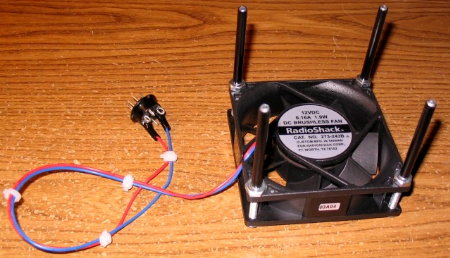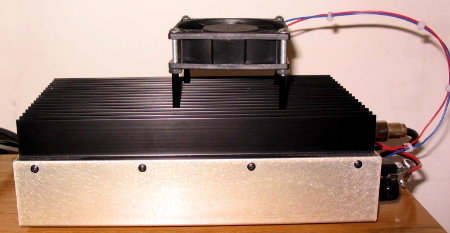Virtually
everyone who uses the VHF/UHF ham bands has used or will use one
of the ubiquitous “brick” power amplifiers to generate
a little more “oomph” to
their signals. As a general rule these amplifiers require no additional cooling
during normal operation, although there are a few cases - such as the Mirage
B-310-G 100-watt 2-meter mobile amplifier - where a cooling fan is built into
the assembly because the heat sink is small and the amplifier may be used in
a confined space. As I recently discovered, however, there are occasions when
extra cooling is desirable and in some cases absolutely necessary even with
a fixed-station “brick”. One such occasion is when operating
meteor scatter using a digital mode like FSK441A. Transmit and
receive periods are 30 seconds each and long QSOs (up to an hour)
are not uncommon unless the “rocks” (meteors)
are frequent and the resulting “pings” (ionized trails) allow for
faster QSO completion. Under these conditions, heat buildup in the amplifier
can become too much for convection cooling alone, thereby causing the amplifier’s
high-temperature sensor to trip. If this happens the amplifier truly lives
up to its nickname, i.e., it temporarily becomes a “brick.”
It
should be noted that most such amplifiers have a maximum rated duty cycle
of 50%; that is, 50% on and 50% off. Digital meteor scatter modes are 50%
duty cycle since the transmitter is “on” continuously
for the full 30 seconds of transmit time, but the 30-second “off” period
is simply not long enough for the amplifier heat sink to cool sufficiently
before the next “on” cycle.
The result is a heat build-up of the heat sink & chassis. An added downside
to this heat buildup is that even if the amplifier temperature overload doesn’t
trip the heat will raise the noise figure of the built-in receive preamp (if
used) and render the receiving system less sensitive to weak pings.
My first encounter with this overheating problem occurred while attempting
to complete a 2-meter digital meteor scatter QSO with a distant station under conditions
where the “rocks” were not that frequent. About 50 minutes into the QSO
and still waiting for a signal report confirmation, I heard the tell-tale “click” of
the over-temperature relay in the amplifier and saw the red light glaring from
the front panel. The heat sink was almost too hot for me to touch - and I had
been running the 200-watt amplifier (a TE Systems 1412G) at less than maximum
rated output! Obviously, some corrective measures were required. |


